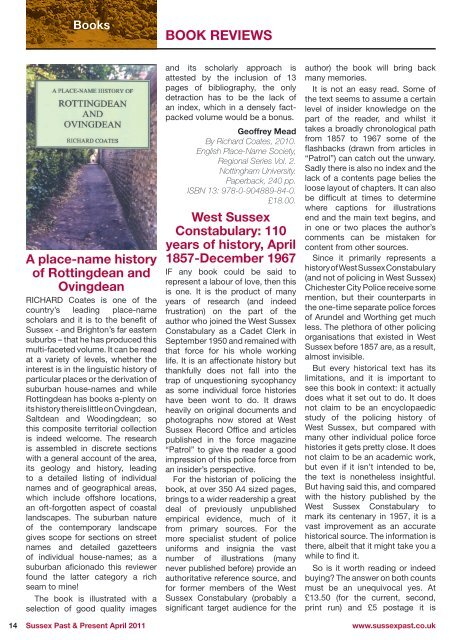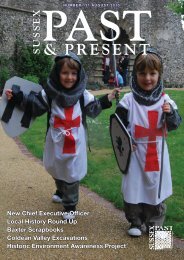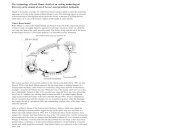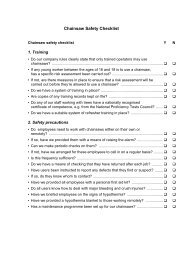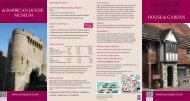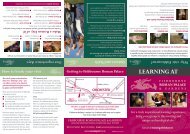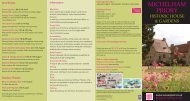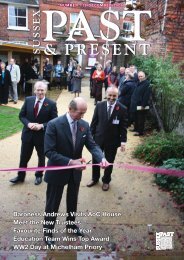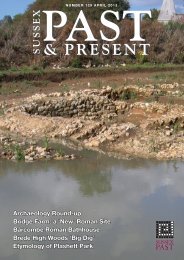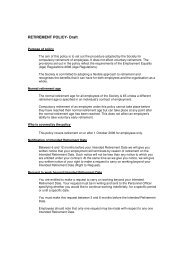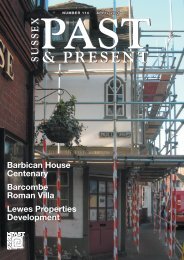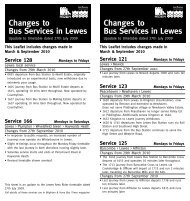April 2011 (issue 123) - The Sussex Archaeological Society
April 2011 (issue 123) - The Sussex Archaeological Society
April 2011 (issue 123) - The Sussex Archaeological Society
Create successful ePaper yourself
Turn your PDF publications into a flip-book with our unique Google optimized e-Paper software.
Books<br />
BOOK REVIEWS<br />
BOOK REVIEWS<br />
Books<br />
A place-name history<br />
of Rottingdean and<br />
Ovingdean<br />
RICHARD Coates is one of the<br />
country’s leading place-name<br />
scholars and it is to the benefit of<br />
<strong>Sussex</strong> - and Brighton’s far eastern<br />
suburbs – that he has produced this<br />
multi-faceted volume. It can be read<br />
at a variety of levels, whether the<br />
interest is in the linguistic history of<br />
particular places or the derivation of<br />
suburban house-names and while<br />
Rottingdean has books a-plenty on<br />
its history there is little on Ovingdean,<br />
Saltdean and Woodingdean; so<br />
this composite territorial collection<br />
is indeed welcome. <strong>The</strong> research<br />
is assembled in discrete sections<br />
with a general account of the area,<br />
its geology and history, leading<br />
to a detailed listing of individual<br />
names and of geographical areas,<br />
which include offshore locations,<br />
an oft-forgotten aspect of coastal<br />
landscapes. <strong>The</strong> suburban nature<br />
of the contemporary landscape<br />
gives scope for sections on street<br />
names and detailed gazetteers<br />
of individual house-names; as a<br />
suburban aficionado this reviewer<br />
found the latter category a rich<br />
seam to mine!<br />
<strong>The</strong> book is illustrated with a<br />
selection of good quality images<br />
and its scholarly approach is<br />
attested by the inclusion of 13<br />
pages of bibliography, the only<br />
detraction has to be the lack of<br />
an index, which in a densely factpacked<br />
volume would be a bonus.<br />
Geoffrey Mead<br />
By Richard Coates, 2010.<br />
English Place-Name <strong>Society</strong>,<br />
Regional Series Vol. 2.<br />
Nottingham University.<br />
Paperback, 240 pp.<br />
ISBN 13: 978-0-904889-84-0.<br />
£18.00.<br />
West <strong>Sussex</strong><br />
Constabulary: 110<br />
years of history, <strong>April</strong><br />
1857-December 1967<br />
IF any book could be said to<br />
represent a labour of love, then this<br />
is one. It is the product of many<br />
years of research (and indeed<br />
frustration) on the part of the<br />
author who joined the West <strong>Sussex</strong><br />
Constabulary as a Cadet Clerk in<br />
September 1950 and remained with<br />
that force for his whole working<br />
life. It is an affectionate history but<br />
thankfully does not fall into the<br />
trap of unquestioning sycophancy<br />
as some individual force histories<br />
have been wont to do. It draws<br />
heavily on original documents and<br />
photographs now stored at West<br />
<strong>Sussex</strong> Record Office and articles<br />
published in the force magazine<br />
“Patrol” to give the reader a good<br />
impression of this police force from<br />
an insider’s perspective.<br />
For the historian of policing the<br />
book, at over 350 A4 sized pages,<br />
brings to a wider readership a great<br />
deal of previously unpublished<br />
empirical evidence, much of it<br />
from primary sources. For the<br />
more specialist student of police<br />
uniforms and insignia the vast<br />
number of illustrations (many<br />
never published before) provide an<br />
authoritative reference source, and<br />
for former members of the West<br />
<strong>Sussex</strong> Constabulary (probably a<br />
significant target audience for the<br />
author) the book will bring back<br />
many memories.<br />
It is not an easy read. Some of<br />
the text seems to assume a certain<br />
level of insider knowledge on the<br />
part of the reader, and whilst it<br />
takes a broadly chronological path<br />
from 1857 to 1967 some of the<br />
flashbacks (drawn from articles in<br />
“Patrol”) can catch out the unwary.<br />
Sadly there is also no index and the<br />
lack of a contents page belies the<br />
loose layout of chapters. It can also<br />
be difficult at times to determine<br />
where captions for illustrations<br />
end and the main text begins, and<br />
in one or two places the author’s<br />
comments can be mistaken for<br />
content from other sources.<br />
Since it primarily represents a<br />
history of West <strong>Sussex</strong> Constabulary<br />
(and not of policing in West <strong>Sussex</strong>)<br />
Chichester City Police receive some<br />
mention, but their counterparts in<br />
the one-time separate police forces<br />
of Arundel and Worthing get much<br />
less. <strong>The</strong> plethora of other policing<br />
organisations that existed in West<br />
<strong>Sussex</strong> before 1857 are, as a result,<br />
almost invisible.<br />
But every historical text has its<br />
limitations, and it is important to<br />
see this book in context: it actually<br />
does what it set out to do. It does<br />
not claim to be an encyclopaedic<br />
study of the policing history of<br />
West <strong>Sussex</strong>, but compared with<br />
many other individual police force<br />
histories it gets pretty close. It does<br />
not claim to be an academic work,<br />
but even if it isn’t intended to be,<br />
the text is nonetheless insightful.<br />
But having said this, and compared<br />
with the history published by the<br />
West <strong>Sussex</strong> Constabulary to<br />
mark its centenary in 1957, it is a<br />
vast improvement as an accurate<br />
historical source. <strong>The</strong> information is<br />
there, albeit that it might take you a<br />
while to find it.<br />
So is it worth reading or indeed<br />
buying? <strong>The</strong> answer on both counts<br />
must be an unequivocal yes. At<br />
£13.50 (for the current, second,<br />
print run) and £5 postage it is<br />
quite exceptional value for money.<br />
Unless and until someone gets<br />
round to a decent postgraduate<br />
thesis on the subject this book is<br />
likely to be seminal, and rightly so.<br />
<strong>The</strong> author can be contacted<br />
at 10 Duxford Close, Tangmere,<br />
Chichester, PO20 2JH or via e-mail<br />
on malmar.barrett@btinternet.<br />
com<br />
Dr Derek Oakensen<br />
Old Police Cells Museum <strong>Society</strong><br />
By Malcolm Barrett, 2010.<br />
M & M Barrett, Tangmere.<br />
<strong>The</strong> Discovery of<br />
SUSSEX<br />
WHAT more could Peter Brandon<br />
possibly have to say about <strong>Sussex</strong>?<br />
In a seemingly constant stream of<br />
publications, beginning for most of<br />
us with his <strong>The</strong> <strong>Sussex</strong> Landscape<br />
in 1974, he has been at the forefront<br />
of British academic regional writers,<br />
inviting us to think of the interplay<br />
between landscape history, artistic<br />
creativity and conservation.<br />
<strong>The</strong>re is, however, one important<br />
difference from his earlier<br />
publications. <strong>The</strong> latter offered<br />
long-term narratives relating<br />
to particular places: the South<br />
Downs, the Weald, or the historic<br />
county of <strong>Sussex</strong>. But this latest<br />
volume is thematic. It examines the<br />
social, cultural and environmental<br />
changes within <strong>Sussex</strong> from the<br />
end of the 18 th century through to<br />
1939 – covering roughly 150 years<br />
of ‘discovery’. Much is linked to<br />
the influx of Londoners to <strong>Sussex</strong><br />
and their impact on a county which<br />
otherwise seemed more resistant<br />
to metropolitan influence than<br />
other counties equidistant from<br />
the capital. <strong>The</strong>re were many who<br />
encouraged and initiated change,<br />
but also many who abhorred<br />
modernity in its many guises.<br />
Rapid urbanisation precipitated its<br />
own counter-culture, and <strong>Sussex</strong><br />
saw a remarkable flowering of<br />
painting, writing, arts and crafts<br />
design, vernacular architecture<br />
and landscape design, all charted<br />
carefully through this volume.<br />
Chapter 19 on Eric Gill and the<br />
artistic communities of Ditchling<br />
is a particularly delightful and<br />
knowledgeable example of these<br />
trends. We also hear of the radical<br />
poet Charlotte Smith, ensconced<br />
in the district around Bignor Park in<br />
the late 18 th century, writing of class<br />
warfare and moral degradation,<br />
and criticising the ‘polluted, smoky<br />
atmosphere and dark and stuffy<br />
streets’ of London and yearning<br />
for her South Downs. And other<br />
personalities loom large in the book:<br />
Belloc and Kipling make repeated<br />
appearances, and if Brandon<br />
characterises Belloc’s <strong>The</strong> Four<br />
Men (1912) as “the most passionate<br />
book on <strong>Sussex</strong>” (p.217), one could<br />
summon up a decent argument for<br />
making <strong>The</strong> Discovery of <strong>Sussex</strong> a<br />
close second!<br />
In any such examination of the<br />
discovery of a county there is one<br />
potential pitfall. Whose accounts<br />
are we following? Who had the<br />
articulacy to commit their thoughts<br />
on paper, for good or ill? Is the<br />
account therefore, one seen from<br />
above, from outside, from the<br />
vantage point of the literati? <strong>The</strong><br />
view of the discoverer, not the<br />
discovered? It can be argued that<br />
such a stance is inevitable, and<br />
we are certainly reminded of the<br />
existence of the <strong>Sussex</strong> natives<br />
but they are too often seen from<br />
outside, rather than revealing the<br />
complexities of the society, culture<br />
and economy that was to be<br />
discovered by incomers. How can<br />
we acquiesce, as Brandon seems<br />
to do, with Lady Asquith, who saw<br />
the only signs of the First World<br />
War in Brighton as being poor,<br />
legless men? Did she go anywhere<br />
near the Royal Pavilion, being used<br />
as a hospital for Indian troops? It is<br />
also surely going too far to suggest,<br />
as he does, that between 1918<br />
and 1939 “the most characteristic<br />
feature of country villages was the<br />
young man in the old cottages<br />
bursting forth with a motor cycle,<br />
collection of books, and strong<br />
and well-informed opinions as to<br />
the state of society…” (p.191). This<br />
is one example of a persuasive<br />
argument, almost a polemic, to<br />
promote what he refers to as ‘the<br />
<strong>Sussex</strong> tradition’ of a leading<br />
region for the manufacturing of the<br />
rural idyll. While acknowledging<br />
the huge burgeoning of creative<br />
talent which headed for <strong>Sussex</strong>,<br />
this reviewer feels uncomfortable<br />
in the knowledge that similar<br />
arguments might be made for the<br />
West Country, for the Lake District,<br />
or even for other Home Counties.<br />
But it is perhaps the intimate<br />
connection between London’s<br />
push from just 50 miles away and<br />
<strong>Sussex</strong>’s landscape pull for the<br />
creative artists that made such a<br />
difference.<br />
This book is well written, an<br />
erudite, lively and utterly readable<br />
account, even joyous on occasion,<br />
helped by 41 plates and 157 blackand-white<br />
illustrations. <strong>The</strong>re are<br />
some minor bibliographic <strong>issue</strong>s,<br />
but overall the excellent partnership<br />
with Phillimore has produced<br />
another Brandon classic.<br />
Brian Short<br />
Emeritus Professor of Historical<br />
Geography<br />
University of <strong>Sussex</strong><br />
By Peter Brandon, 2010. Phillimore.<br />
ISBN 978-1-86077-616-8. £25.00.<br />
14 <strong>Sussex</strong> Past & Present <strong>April</strong> <strong>2011</strong><br />
www.sussexpast.co.uk www.romansinsussex.co.uk <strong>Sussex</strong> Past & Present <strong>April</strong> <strong>2011</strong> 15


